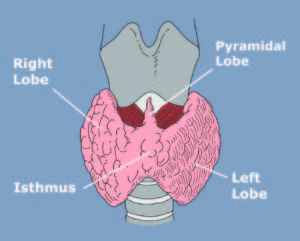Thyroid Anatomy

The thyroid gland consists of two halves – the left lobe and the right lobe. These two lobes of the thyroid gland are connected by a thin strip of tissue called the isthmus. At the top of the isthmus, there is often a small piece of tissue called the pyramidal lobe. This is the remnant of an embryonic connection between the thyroid gland and the base of the tongue.
Thyroid Function
The thyroid gland is considered a master regulator of the body’s metabolism. In other words, the thyroid gland controls how fast the body runs. It does this by producing thyroid hormone. The more thyroid hormone that is released, the faster the body burns fuel and performs its many functions. Symptoms of too much thyroid hormone (hyperthyroidism) include palpitations, weight loss, anxiety, heat intolerance, and diarrhea. If the thyroid gland is not producing enough thyroid hormone (hypothyroidism), the body slows down resulting in weight gain, depression, cold intolerance, and constipation.
Thyroid Hormone
The term thyroid hormone actually refers to two closely related molecules, triiodothyronine (commonly referred to as T3) and thyroxine (T4). Although T4 does have some physiologic activity, T3 is much more biologically active. T4 is considered a prohormone of (i.e., a precursor to) T3. Both T3 and T4 contain iodine derived from the diet. T3 contains 3 iodine atoms, whereas T4 has 4 iodine atoms.
Effects of Thyroid Hormone
Thyroid hormone exerts its effects in the nucleus of a cell, triggering some genes to be expressed and others suppressed. The end result is the regulation of many different processes throughout the body, including:
- How fast the body burns carbohydrates, fats, and proteins
- Heart rate and cardiac output
- Respiratory rate
- Body temperature
Diseases of the Thyroid Gland
Diseases of the thyroid gland can be divided into two groups: 1) dysfunction of the thyroid gland (i.e., producing too much or too little thyroid hormone) and 2) tumors of the thyroid gland. This includes benign nodules and thyroid cancer. More often than not, the presence of thyroid nodules or thyroid cancer has no effect on thyroid function. The most common reason for hyperthyroidism is an autoimmune disease known as Graves’ disease. The most common reason for hypothyroidism is another autoimmune disease called Hashimoto’s thyroiditis. The causes for thyroid nodules and thyroid cancer are still poorly understood.
